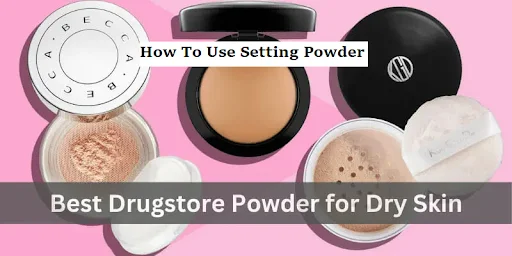Introduction to Setting Powder
- Embarking on the journey of mastering makeup is akin to stepping into an artist’s realm, and within this vast palette of beauty, setting powder emerges as a key brushstroke. As a beginner navigating the nuances of Health and Beauty, understanding the pivotal role of setting powder in elevating your makeup game is paramount. Setting powder plays a crucial role in the world of makeup. As a beginner, understanding its purpose is essential. Not only does it set your foundation and concealer, but it also acts as a final touch, providing a polished and long-lasting look. If you are interested related to the Skin Beauty and Wellness article click on the link.
Choosing the Right Setting Powder:
- Selecting the right setting powder involves considering various factors. Beginners often find translucent powders to be versatile. However, delving into options based on skin type, undertone, and finish can further enhance the makeup experience.
- Step-by-Step Guide on Application:
- Start with a freshly cleansed and moisturized face.
- Apply your chosen foundation and concealer as usual, ensuring an even base.
- Dip into the setting powder using a fluffy powder brush or makeup sponge.
- Gently tap off any excess powder to avoid overapplication.
- Apply a light layer, focusing on areas prone to oiliness or where makeup creases.
Baking Technique and its Benefits:
- The baking technique, popularized by makeup artists, involves applying a thicker layer of setting powder to specific areas. Letting it “bake” for a few minutes allows the powder to set the makeup more intensely, resulting in a longer-lasting finish. This technique is especially beneficial for under-eye areas and the T-zone.
How much setting powder is too much?
- While it varies, starting with a small amount and gradually building up is recommended. This prevents an overly powdery look.
Can individuals with dry skin use setting powder?
- Yes, but with caution. Ensure your skin is well-hydrated before application to avoid emphasizing dry patches.
Setting Powder for Different Skin Types:
- Oily Skin: Focus on powdering the T-zone and areas prone to shine. Consider using oil-absorbing setting powders for better results.
- Dry Skin: Apply setting powder sparingly, paying attention to areas where makeup tends to settle. Opt for hydrating setting powders for a luminous finish.
- Combination Skin: Customize your application based on the specific needs of different facial areas. Balancing hydration and matte finishes is key.
Importance of Blending:
- Achieving a seamless finish is crucial. After applying the setting powder, take the time to blend thoroughly. This step ensures the powder integrates seamlessly into your makeup, preventing a chalky or uneven appearance.
- Touch-Ups and When to Use Setting Powder:
- Carry a clean brush for on-the-go touch-ups. Dust away excess oil or makeup settling into fine lines for a refreshed look.
- Setting powder isn’t limited to the face. Explore its utility in setting lipstick, preventing mascara smudging, and controlling eyebrow products for an all-encompassing makeup routine.
- Advanced Techniques:
- Explore advanced setting techniques like the “cooking” method to achieve a more airbrushed finish.
- Experiment with setting sprays to lock in makeup for extended wear.
- Setting Powder as a Makeup Artist’s Secret:
-
- Learn how professional makeup artists utilize setting powder in their craft.
- Discover insider tips and tricks for achieving red-carpet-worthy looks.
How difficult it can be to find the right makeup products Best Setting Powder list read the full article.
- The Evolution of Setting Powders:
- DIY Setting Powder:
- For the creative souls, explore making your setting powder at home using natural ingredients.
- Understand the benefits and considerations of DIY alternatives.
- Trace the history and evolution of setting powders in the beauty industry.
- Explore innovations and trends shaping the future of setting powder.
Top 5 FAQs About Using Setting Powder
- Q1: How much setting powder should I use?
- Start with a small amount and build up as needed. Adjust based on personal preferences and desired matte finish.
- Q2: Can individuals with dry skin use setting powder?
- Yes, but ensure proper skin hydration before application. Choose hydrating setting powders to avoid emphasizing dry patches.
- Q3: What is the purpose of the baking technique?
- The baking technique enhances makeup longevity by applying a thicker layer of setting powder to specific areas, letting it sit, and then brushing away the excess.
- Q4: How does setting powder benefit different skin types?
- Oily Skin: Controls shine, especially in the T-zone.
- Dry Skin: Sets makeup without emphasizing dry patches when applied sparingly.
- Combination Skin: Customize application based on specific facial areas.
- Q5: When and how should I perform touch-ups with setting powder?
- Use a clean brush for touch-ups throughout the day, focusing on areas with shine or where makeup settles into fine lines for a refreshed look.
In Conclusion
The highlights setting powder as a transformative tool, urging readers to view it not just as a final touch but as a brushstroke that enhances their unique beauty. Whether controlling shine, providing a subtle glow, or facilitating strategic touch-ups, setting powder emerges as a valuable ally in the makeup routine. The guide encourages readers to integrate the elegance of setting powder into their beauty rituals, fostering confidence and self-expression with each application.

